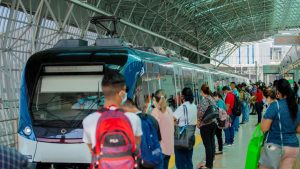 Alstom launched a new version of Mastria multimodal supervision solution that uses artificial intelligence which allows transport operators to adapt, easily and in real time, their offer to the various social distancing and public gathering requirements that have arisen due to the coronavirus pandemic.
Alstom launched a new version of Mastria multimodal supervision solution that uses artificial intelligence which allows transport operators to adapt, easily and in real time, their offer to the various social distancing and public gathering requirements that have arisen due to the coronavirus pandemic.
The mobility orchestration solution gives operators higher visibility on passenger distribution and flow in trains and stations, as well as enhanced predictive capabilities. This equates to the ability to anticipate and control passenger density and operations in real time, adapting train frequency, capacity and the required number of trains, as well as passenger flows into stations, among other things.
Matching the supply of trains with the demand optimises operating conditions, including costs, and is especially useful for managing fluctuating demand peaks, such as during rush hours or special events, or special mobility restrictions, as in the case of Covid-19.
The new implementation of Mastria aggregates information on passenger demand from train weight sensors, ticketing machines, traffic signalling, management systems, surveillance cameras and mobile networks in order to offer a real-time picture of passenger flows.
Mastria multimodal supervision solution processes the information and provides operators with the information and recommendations necessary to ensure and anticipate specified levels of occupation, as a percentage of maximum capacity, at all times. It can suggest increasing trains frequency, redistributing the flow of people to particular stations, readjustments to other transport systems that impact the metro, restricting entry to stations or even managing the distribution of passengers on the platform to align them with cars with more space on a given train. Mastria’s powerful prediction algorithms anticipate these situations, allowing proper planning of the entire system.
Alstom’s Mastria solution was implemented for Panama Metro at the end of 2019 to analyse traveller flows and offer a way to avoid the saturation that appeared at unpredictable times and only in certain stations.
In only three months, and thanks to deep learning techniques localized saturation could be predicted up to 30 minutes before it could be visibly observed, thereby allowing remedial action that reduced waiting times in stations by 12%.
Due to coronavirus pandemic, the same technology is being used to adapt the operational actions that maintain the train’s load to 40% of its maximum capacity, as recommended by the country’s health authorities. Using various data sources, such as user travel information and the weight of cars, new features have been developed such as real-time monitoring of passenger density and flows in stations and trains, with new predictive alerts, simulation of opening and closing access to the stations and analysis of the distribution of passengers throughout the length of the trains.
Multimodal supervision, traffic management, coordination of operations and predictive analysis are Mastria’s four main standard functions which are highly configurable and can be combined according to the needs of operators and the global mobility network environment.
Share on:



